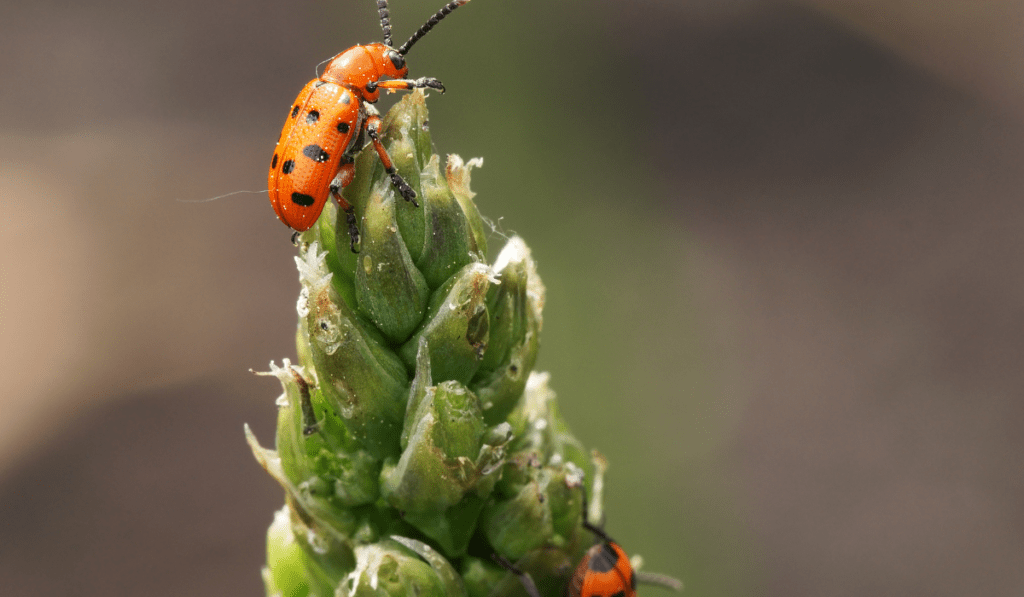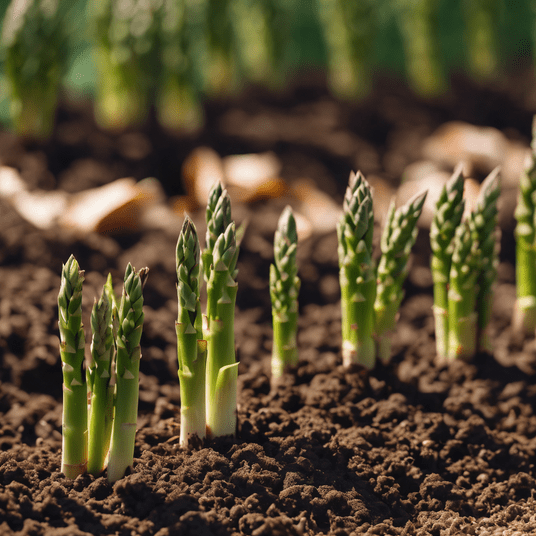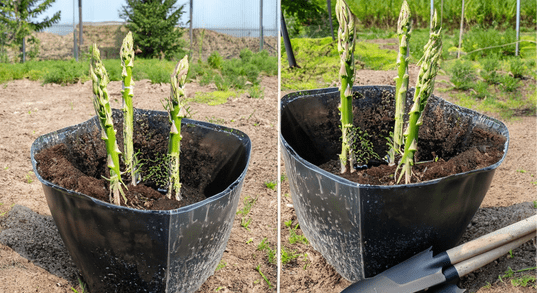Unveiling the Hidden Threats to Your Asparagus Harvest
Asparagus cultivation is a rewarding endeavor, but lurking beneath the soil and amongst the ferns are pests that can jeopardize your harvest. In this guide, we’ll delve into the world of asparagus pests, empowering you with knowledge to protect your crop.
Importance of Pest Management in Asparagus
Role of Pests: How pests impact the overall health, yield, and quality of asparagus
Economic Impact: Understanding the potential damage and economic consequences of untreated pest infestations
09 Most Common Pest Asparagus
1. Asparagus Beetle
Identification: The Asparagus Beetle, a distinctive intruder, can be identified by its vibrant blue-black hue with reddish-orange spots. Its segmented body and prominent antennae make it stand out among garden pests.
Signs of Infestation: Keep a keen eye on your asparagus ferns for telltale signs of damage. Asparagus Beetle larvae defoliate the ferns, leaving behind a lacy, skeletonized appearance. Adult beetles, on the other hand, create visible feeding marks.
Prevention and Treatment: Combat these beetles by introducing natural predators like parasitic wasps or deploying companion plants like tomatoes. Embrace organic control methods such as neem oil or diatomaceous earth to deter and disrupt their life cycle.
2. Asparagus Aphids
Identification: Asparagus Aphids, small and pear-shaped, come in shades of green or purple. Keep an eye out for these tiny invaders clustered on the undersides of asparagus ferns.
Damage: Aphids can cause significant harm by siphoning sap from plants, leading to distorted growth and potential virus transmission.
Management Strategies: Introduce beneficial insects like ladybugs or lacewings, use neem oil as a natural deterrent, and implement cultural controls such as spraying plants with a strong jet of water to dislodge aphid colonies.
3. Cutworms
Identification: Cutworms, nocturnal caterpillars with a smooth exterior, are known for their habit of curling into a C-shape when disturbed.
Signs of Damage: Detect cutworm feeding by observing irregular cuts on asparagus shoots, often near the soil line.
Control Measures: Create protective barriers around asparagus plants, deploy beneficial nematodes to target cutworm larvae, and utilize organic pesticides sparingly.
4. Asparagus Rust
Identification: Asparagus Rust manifests as orange pustules on ferns, resembling rust on metal. These pustules release spores that contribute to the spread of the disease.
Prevention and Treatment: Ensure proper spacing between plants to promote air circulation, consider fungicides as a preventive measure, and choose asparagus varieties resistant to rust.
5. Asparagus Miner
Identification: Asparagus Miners, small fly larvae, tunnel into asparagus stems and cause browning.
Damage: Identify infestation by observing wilting or browning of asparagus shoots.
IPM Techniques: Encourage beneficial insects like parasitic wasps, maintain garden hygiene to eliminate potential breeding grounds, and consider introducing natural enemies to control the miner population.
6. Thrips
Identification: Thrips are tiny, slender insects with fringed wings, often found on asparagus foliage.
Effects on Asparagus: Thrips damage plants by piercing cells and sucking out their contents, resulting in stippling, discoloration, and distorted growth.
Natural Control Methods: Combat thrips with predatory insects like minute pirate bugs or use neem oil to deter them effectively.
7. Nematodes
Identification: Identify nematode damage through stunted growth, wilting, and yellowing of asparagus plants.
Symptoms: Recognize nematode-infested plants by observing root knots or galls on the root system.
Prevention and Management: Implement crop rotation, solarize the soil to reduce nematode populations, and select asparagus varieties resistant to nematode damage.
8. Whiteflies
Identification: Whiteflies are small, winged insects with a powdery appearance when disturbed, often found on the undersides of leaves.
Damage: Their feeding causes yellowing, leaf curling, and the transmission of plant viruses.
Control Strategies: Introduce natural enemies like parasitic wasps, use insecticidal soap, and consider reflective mulch to deter whiteflies.
9. Wireworms
Identification: Wireworms, slender and brown, are the larval stage of click beetles and are found in the soil.
Signs of Infestation: Detect wireworm damage through irregular holes in asparagus tubers and roots.
Remediation Techniques: Combat wireworms by planting trap crops, introducing beneficial nematodes, and amending the soil to discourage their presence.
Understanding the characteristics, signs, and effective control measures for these common asparagus pests empowers you to protect your asparagus patch and ensure a bountiful harvest. In the next section, we’ll explore preventive measures and Integrated Pest Management (IPM) strategies to fortify your asparagus garden against potential threats.
Preventive Measures and Integrated Pest Management (IPM) for Asparagus
Effective pest management is not only about responding to threats but, more importantly, about preventing them in the first place. In this section, we’ll delve into crucial preventive measures and the principles of Integrated Pest Management (IPM) to ensure your asparagus garden thrives pest-free.
Importance of Early Detection: Regular Inspection and Scouting
Early detection is the linchpin of successful pest management. Regularly inspecting your asparagus plants allows you to catch potential issues before they escalate. Here’s how you can incorporate early detection into your routine:
- Visual Scouting: Regularly walk through your asparagus patch, examining plants for any signs of pests or unusual patterns.
- Underside Inspection: Lift ferns and inspect the undersides of leaves, where pests like aphids and spider mites often hide.
- Shoot Examination: Pay close attention to young asparagus shoots, as they are particularly vulnerable to pests like cutworms.
- Record Keeping: Maintain a gardening journal to track the appearance of pests, their locations, and the effectiveness of any interventions.
Overview of Integrated Pest Management (IPM): Holistic Strategies for Effective Pest Management
IPM is a holistic approach that combines various strategies to manage pests in a sustainable and environmentally friendly manner. Here are the key components of an IPM approach for asparagus:
- Biological Controls: Introduce natural predators of pests, such as ladybugs, parasitic wasps, or nematodes, to keep pest populations in check.
- Companion Planting: Cultivate plants that repel or distract pests. For example, planting tomatoes alongside asparagus can help deter asparagus beetles.
- Crop Rotation: Rotate your asparagus crop to different areas of your garden each year to disrupt the life cycle of soil-dwelling pests.
- Beneficial Plants: Grow companion plants like marigolds, which can deter nematodes and other soil pests.
- Trap Crops: Plant sacrificial crops that attract pests away from asparagus, such as planting dill to attract aphids.
Creating a Pest-Resistant Environment: Embracing Cultural Practices and Companion Planting
Beyond IPM, certain cultural practices and companion planting can significantly contribute to creating a pest-resistant environment for your asparagus:
- Well-Spaced Planting: Avoid overcrowding asparagus plants, as good air circulation can prevent fungal diseases.
- Proper Watering: Water at the base of plants to discourage foliar diseases, and avoid overwatering to prevent conditions favorable to pests.
- Mulching: Apply organic mulch to deter weeds and create a barrier against pests, such as cutworms.
- Neighboring Plants: Choose companion plants strategically. For example, basil planted near asparagus can enhance its flavor and may help repel certain pests.
Conclusion
Recap of Common Asparagus Pests: Summarizing key information on the identified pests
Empowerment: Encouraging readers to apply preventive measures for a thriving asparagus harvest
Closing Thoughts: Concluding with the promise of a pest-free and abundant asparagus yield



